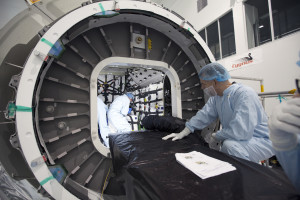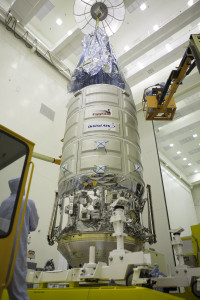 The next U.S. cargo delivery to the International Space Station is steadily progressing toward launch. An Orbital ATK Cygnus spacecraft is at NASA’s Kennedy Space Center in Florida undergoing a final round of prelaunch preparations for its December liftoff aboard a United Launch Alliance Atlas V rocket. This will be Orbital ATK’s fourth commercial resupply flight to the station and will carry more than 7,000 pounds of supplies, equipment and research to keep the station stocked and capable of serving as a platform for studies off the Earth, for the Earth. Read the details of Cygnus processing here. Photo credit: NASA/Dmitri Gerondidakis
The next U.S. cargo delivery to the International Space Station is steadily progressing toward launch. An Orbital ATK Cygnus spacecraft is at NASA’s Kennedy Space Center in Florida undergoing a final round of prelaunch preparations for its December liftoff aboard a United Launch Alliance Atlas V rocket. This will be Orbital ATK’s fourth commercial resupply flight to the station and will carry more than 7,000 pounds of supplies, equipment and research to keep the station stocked and capable of serving as a platform for studies off the Earth, for the Earth. Read the details of Cygnus processing here. Photo credit: NASA/Dmitri Gerondidakis
Cygnus Prepped for More Cargo Loading
Engineers are opening the hatch on the Enhanced Cygnus spacecraft and the spacecraft is being rotated to its horizontal position today in the Payload Hazardous Servicing Facility at NASA’s Kennedy Space Center during preparations for launch December 3 to the International Space Station.
The Orbital ATK-built spacecraft, which will carry more than 7,000 pounds of equipment, experiments and supplies, is being moved and opened so teams can load the last of the gear slated for this resupply mission. The stowage loading will take place Nov. 8 to 10.
Also on Nov. 8, the Delta Mariner will dock at Port Canaveral to deliver the first stage of the United Launch Alliance Atlas V rocket that will lift the Enhanced Cygnus into orbit. The booster stage will be hoisted into the Vertical Integration Facility at Space Launch Complex 41 on Nov. 11. The latest version of the Cygnus is bigger than its predecessors and can carry 25 percent more supplies on unpiloted missions to the space station. Photo credit: NASA/Kim Shiflett
Cygnus Propellants Loaded; Team Prepares for Final Cargo Installation
 Orbital ATK technicians have finished loading fuel and oxidizer into the Cygnus service module and are already preparing to remove the hatch and rotate the spacecraft from vertical to horizontal inside the Payload Hazardous Servicing Facility at NASA’s Kennedy Space Center in Florida. The move will allow team members to pack away late-stow cargo items bound for the International Space Station.
Orbital ATK technicians have finished loading fuel and oxidizer into the Cygnus service module and are already preparing to remove the hatch and rotate the spacecraft from vertical to horizontal inside the Payload Hazardous Servicing Facility at NASA’s Kennedy Space Center in Florida. The move will allow team members to pack away late-stow cargo items bound for the International Space Station.
The spacecraft will launch aboard a United Launch Alliance Atlas V rocket on the company’s fourth commercial resupply flight to the orbiting laboratory. Photo by NASA/Kim Shiflett.
Orbital ATK Offers Look at Enhanced Cygnus
Orbital ATK is out with a short feature about the Enhanced Cygnus spacecraft that will carry experiments, equipment and supplies to the International Space Station crew in December. The new spacecraft carries 25 percent more cargo than its predecessor and features a number of changes such as the more efficient solar arrays seen unfurled in the photo above from Orbital ATK. Read more from Orbital ATK here.
The Enhanced Cygnus is to launch atop a United Launch Alliance Atlas V rocket from Cape Canaveral Air Force Station in Florida with about 5,900 pounds of materials. The spacecraft will not carry any crew. Station astronauts will use the robotic arm on the orbiting laboratory to grasp the Enhanced Cygnus as it approaches and connect it to a port for unloading.
Cygnus Spacecraft Moves to PHSF, Begins Early Preps for Propellant Loading
The Cygnus spacecraft that will carry nearly 6,000 pounds of cargo on the next U.S. resupply flight to the International Space Station moved late yesterday from the Space Station Processing Facility to the Payload Hazardous Servicing Facility (PHSF) at NASA’s Kennedy Space Center in Florida. Today it moves into the building’s high bay, where it will be uncovered, removed from atop its transporter, and placed into a work stand to begin preparations for propellant loading next week.
Developed and built by Orbital ATK, the Cygnus comprises the pressurized cargo module and attached service module, which houses the solar arrays and propulsion system. The spacecraft is set to deliver equipment, supplies and research to the station on the company’s fourth Commercial Resupply Services flight.
Launch aboard a United Launch Alliance Atlas V is scheduled for Dec. 3 from Space Launch Complex 41 at nearby Cape Canaveral Air Force Station.
Centaur Upper Stage Arrives Ahead of Next Station Commercial Resupply Flight
 The Centaur upper stage slated to help deliver the next U.S. cargo delivery to the International Space Station is on site at Cape Canaveral Air Force Station in Florida. The upper stage will top the United Launch Alliance Atlas V rocket set to launch Orbital ATK’s Cygnus spacecraft on a flight to carry equipment, supplies and research to the orbiting laboratory in December.
The Centaur upper stage slated to help deliver the next U.S. cargo delivery to the International Space Station is on site at Cape Canaveral Air Force Station in Florida. The upper stage will top the United Launch Alliance Atlas V rocket set to launch Orbital ATK’s Cygnus spacecraft on a flight to carry equipment, supplies and research to the orbiting laboratory in December.
Following its Tuesday afternoon arrival, the single-engine Centaur was transported into the Horizontal Integration Facility at Space Launch Complex 37 to begin prelaunch processing.
The uncrewed flight will be Orbital’s fourth commercial resupply mission to the station. It is targeted for liftoff Dec. 3 from Space Launch Complex 41.
NASA Wallops Completes Initial Assessment After Orbital Launch Mishap; Blog Coverage Concludes
The Wallops Incident Response Team completed today an initial assessment of Wallops Island, Virginia, following the catastrophic failure of Orbital Science Corp.’s Antares rocket shortly after liftoff at 6:22 p.m. EDT Tuesday, Oct. 28, from Pad 0A of the Mid-Atlantic Regional Spaceport at NASA’s Wallops Flight Facility in Virginia.

“I want to praise the launch team, range safety, all of our emergency responders and those who provided mutual aid and support on a highly-professional response that ensured the safety of our most important resource — our people,” said Bill Wrobel, Wallops director. “In the coming days and weeks ahead, we’ll continue to assess the damage on the island and begin the process of moving forward to restore our space launch capabilities. There’s no doubt in my mind that we will rebound stronger than ever.”
The initial assessment is a cursory look; it will take many more weeks to further understand and analyze the full extent of the effects of the event. A number of support buildings in the immediate area have broken windows and imploded doors. A sounding rocket launcher adjacent to the pad, and buildings nearest the pad, suffered the most severe damage.
At Pad 0A the initial assessment showed damage to the transporter erector launcher and lightning suppression rods, as well as debris around the pad.
The Wallops team also met with a group of state and local officials, including the Virginia Department of Environmental Quality, the Virginia Department of Emergency Management, the Virginia Marine Police, and the U.S. Coast Guard.
The Wallops environmental team also is conducting assessments at the site. Preliminary observations are that the environmental effects of the launch failure were largely contained within the southern third of Wallops Island, in the area immediately adjacent to the pad. Immediately after the incident, the Wallops’ industrial hygienist collected air samples at the Wallops mainland area, the Highway 175 causeway, and on Chincoteague Island. No hazardous substances were detected at the sampled locations.
Additional air, soil and water samples will be collected from the incident area as well as at control sites for comparative analysis.
The Coast Guard and Virginia Marine Resources Commission reported today they have not observed any obvious signs of water pollution, such as oil sheens. Furthermore, initial assessments have not revealed any obvious impacts to fish or wildlife resources. The Incident Response Team continues to monitor and assess.
Following the initial assessment, the response team will open the area of Wallops Island, north of the island flagpole opposite of the launch pad location, to allow the U.S. Navy to return back to work.
Anyone who finds debris or damage to their property in the vicinity of the launch mishap is cautioned to stay away from it and call the Incident Response Team at 757-824-1295.
Further updates on the situation and the progress of the ongoing investigation will be available at:
and
NASA Statement Regarding Oct. 28 Orbital Sciences Corp. Launch Failure

The following statement is from William Gerstenmaier, Associate Administrator of NASA’s Human Exploration and Operations Directorate, regarding the launch failure that occurred at Pad 0A of the Mid-Atlantic Regional Spaceport at NASA’s Wallops Flight Facility in Virginia during the attempted launch of Orbital Sciences Corp’s Antares rocket and Cygnus cargo spacecraft at 6:22 p.m. Tuesday, Oct. 28.
“While NASA is disappointed that Orbital Sciences’ third contracted resupply mission to the International Space Station was not successful today, we will continue to move forward toward the next attempt once we fully understand today’s mishap. The crew of the International Space Station is in no danger of running out of food or other critical supplies.
“Orbital has demonstrated extraordinary capabilities in its first two missions to the station earlier this year, and we know they can replicate that success. Launching rockets is an incredibly difficult undertaking, and we learn from each success and each setback. Today’s launch attempt will not deter us from our work to expand our already successful capability to launch cargo from American shores to the International Space Station.”
› NASA’s Orbital webpage
› Video of NASA news conference following mishap
Antares, CRS-3 Debris
Damage related to the Oct. 28 launch attempt of an Antares rocket was contained to the hazard area, but there may have been a scattering of debris. Public safety is our No. 1 priority. If people find debris in the vicinity of the launch, please stay away and call the Incident Response Team at 757-824-1295.
NASA, Orbital CRS-3 Press Conference Scheduled
The Orbital Sciences Corp.’s Antares rocket lifted off to start its third resupply mission to the International Space Station, but suffered a catastrophic anomaly shortly after liftoff at 6:22 p.m. EDT.
The Orbital Sciences team is executing its contingency procedures, securing the site and data, including all telemetry from the Antares launch vehicle and Cygnus spacecraft.
Before launch the Orbital team was not tracking any issues.
No injuries have been reported, and Orbital reports that all personnel around the Wallops Flight Facility launch site have been accounted for.
NASA will continue to provide additional updates as they become available. A news conference will be held on NASA TV at 9 p.m. EDT.
Visit http://1.usa.gov/1r42Ssu for the latest information.





